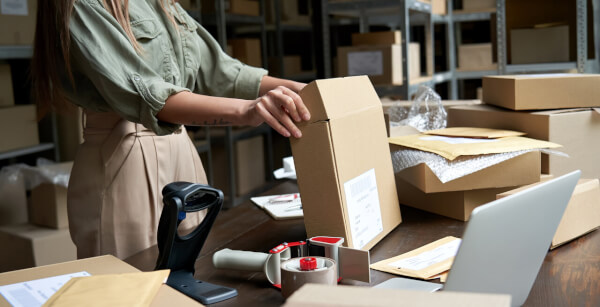Xero pricing Australia: Plans, costs & features guide
Explore Xero pricing in Australia. We break down all 4 plans, hidden costs, and features like payroll & multi-currency. Find more.

Dropshipping has been around for several years now and remains a popular fulfillment method for online commerce, particularly for individuals who are new to running a business. It takes away several of the biggest headaches associated with keeping a business going, including inventory management, packaging, and warehouse costs.
But while it is one of the more straightforward methods of fulfilling customer orders and generating revenue, it is still something that needs to be approached with care and attention. Successful dropshippers still put in the work in terms of market research, promotion, and customer service.
That’s why we’ve prepared this quick guide on everything you need to know in order to start a successful dropshipping business in 2025. We’ll take a look at what dropshipping is, how it works, as well as the common challenges that these types of businesses face.
We’ll also offer some of the best dropshipping platforms available for Australian entrepreneurs and explain how Wise can help manage and enable your cross-border transactions.
| Table of contents |
|---|
Sign up for the Wise Business account! 🚀
Dropshipping is a type of retail fulfillment model whereby the business owner sells and markets their products as they would with any other type of business. But instead of handling stock, packaging, and shipping themselves, they outsource this to third-party vendors and suppliers when they receive an order through their purchasing channels.
There are several advantages to this method of working. Business owners can concentrate fully on simply marketing and promoting their products, greatly reducing their overall costs and responsibilities. This also has the knock-on effect of limiting the overall risk for a business owner, which is why it’s such an attractive proposition for newcomers. And without the need for a physical store, you only need an internet connection to get started.
For suppliers, the inverse is true - they can sell what they produce without having to worry about the retail aspect of business.
The dropshipping process starts in much the same way as any other customer fulfillment model. A business owner will set up a website to sell a selection of products. This can be their own creations, but a dropshipper can also promote and market third-party products made by a specific supplier.

Once a customer order is received, the order details are passed directly to the supplier or manufacturer, and the business owner pays the wholesale cost for the order. The supplier will then process the order and package it before shipping it out to the customer.
There is no direct contact between the customer and the supplier - the business owner remains the point of contact for the transaction at all times. This is where a business owner can build their reputation by providing regular updates and offering excellent customer service throughout the process.
Australia is a great place for aspiring dropshippers to get started with their online business or side hustle. There are several excellent platforms available to choose from, with each of the names we’ve provided catering to specific audiences or circumstances.
It should be noted that you can use platforms such as Shopify and WooCommerce for dropshipping. However, we will be mostly focusing on Australian-based suppliers in this instance.
DropshipZone is a well-known and well-respected dropshipping supplier that is exclusive to the Australian market1.
Pros:
Cons:
DropshipZone has close links to several of the leading carriers across the country, including Australian Post and Aramax Toll. They offer distinctive product categorisation, making it easy for prospective dropshippers to find and select the exact products they would like to sell2.
It also has the added convenience of having GST costs added automatically to all products paid for. It’s also free to sign up, with no subscription or membership fees. They can offer discounts on bulk purchasing if certain conditions are met, though this does mean that you will need to hold the stock yourself, which could be viewed as a little counterintuitive3.
While the fact that they only ship within Australia does limit scaling potential, its fast shipping and generous warranty conditions make DropshipZone a very solid option.
Best for: Fast, domestic shipping
When it comes to pure product numbers and suppliers, SaleHoo is tough to beat.
Pros:
Cons:
With over 8,000 vetted suppliers and more than 2.5 million products available, SaleHoo has more than enough choice to cater for almost any type of business niche and sector4. It’s also quite advanced in terms of the technology it uses, with excellent product research tools and market insights (optional add-on) available to help their dropshippers5.
It does, however, come with pricing plans which are a little on the expensive side. The Pro plan starts at $49USD/mo, but the Market Insights add-on comes with its own separate subscription fee of $20USD/mo. However, there is a Beginner plan for $9USD/mo which is good for those just getting started6.
Where SaleHoo does excel is in what it offers those new to entrepreneurship, with comprehensive training guides across all subjects related to dropshipping7. So while it might be pricey, what you get for the cost is quite substantial.
Best for: Complete beginners, those wanting a wide product selection
Spocket might not have made this list a couple of years ago. Its USP was that it only used suppliers based in the US or the EU, making delivery times much faster than from those suppliers who sourced from China. Of course, for Australian customers, this wasn’t especially helpful.
That all changed when they started to partner with Australian suppliers, which greatly reduced delivery times on certain products. This was on top of their established network, giving Australian dropshippers a considerable range of choice in terms of suppliers and products8.
Pros:
Cons:
Spocket has a number of pricing plans to choose from. It offers a free seven-day trial for all plans, though it does become quite expensive if you choose to pay monthly, with the starter plan coming in at $39/mo. If you choose to go with annual billing, you do receive eight months free, making it a good alternative option. However, this option is not available on the Beginners plan9.
There aren’t any notable downsides to Spocket. There is perhaps a slight lack of out-of-the-box features when compared to similar platforms - if you wish to offer products from AliExpress or other large-scale retailers such as Temu, for example, you will need to integrate with third-party applications.
Best for: Automation, Ease-of-use
AliDropship is a little different to the other names on this list. It’s not a fully-fledged platform; rather, it’s a powerful plug-in that can be added to existing stores that have been set up on open-source sites such as WordPress. With the plug-in in place, users will gain access to AliExpress’s full catalogue of products. This gives huge scope for product catalogues to sell at very low prices, making dropship stores with this kind of access very popular.
Pros:
Cons:
Stores with this type of design are primed for high levels of customisation thanks to WordPress’s modular infrastructure. The plug-in works particularly well with WooCommerce stores and is available for a one-time payment of $89USD10. Alternatively, you can opt for a payment plan of $39/mo (after a 14-day trial). With this option, AliDropship’s team will build your store from scratch, which is great for individuals lacking confidence in their tech skills11.
The most obvious limitation of AliDropship is the lack of built-in features. WordPress relies on its vast range of third-party plugins, and AliDropship is no different. It gives users a huge choice in terms of what they can do with their store, but the lack of standardisation can be a little tricky to navigate.
Best for: Modular store creation, niche products

Dropshipping is a popular customer fulfillment model for many Australian businesses. However, there are certain unique challenges that present themselves with this type of model.
Some of the most prominent include:
There is also the issue of currency exchanges and overseas payment fees for dropshipping businesses with an international customer base. If you receive payments in AUD but pay suppliers in a foreign currency, exchange rates can hurt profit margins. And many payment platforms, such as Stripe and PayPal, charge additional fees.
As your dropshipping venture expands, you'll likely be paying suppliers in various currencies, like USD for platforms such as SaleHoo or AliDropship. This is where managing international payments efficiently becomes crucial for protecting your profit margins.
A Wise Business account is designed to help with this, allowing you to pay international invoices at the mid-market exchange rate, without the hidden markups often found with traditional banks. By holding funds in over 40+ currencies, you can manage your global finances from a single platform, helping to simplify your operations and letting you focus on growing your business.
Expanding a business globally opens up exciting opportunities, but also new challenges like receiving payments across borders. Hidden foreign transaction fees and hefty currency conversions involved with international payments can eat into your profits and time.
Wise Business serves as a cost-effective solution where you can receive money from around the world at the speed and price of local payments.
Transform the way you receive payments with Wise Business:
Sign up for the Wise Business account! 🚀
This general advice does not take into account your objectives, financial circumstances or needs and you should consider if it is appropriate for you.
Sources:
*Please see terms of use and product availability for your region or visit Wise fees and pricing for the most up to date pricing and fee information.
This publication is provided for general information purposes and does not constitute legal, tax or other professional advice from Wise Payments Limited or its subsidiaries and its affiliates, and it is not intended as a substitute for obtaining advice from a financial advisor or any other professional.
We make no representations, warranties or guarantees, whether expressed or implied, that the content in the publication is accurate, complete or up to date.

Explore Xero pricing in Australia. We break down all 4 plans, hidden costs, and features like payroll & multi-currency. Find more.

Wondering how to reactivate your ABN? Find out more on ABN reactivation, eligibility, required documents, and overall process.

Discover how Xero integration connects works and connects to over 1,000 apps, from ecommerce to payments. Read here.

Learn how to create a compliant tax invoice in Australia. We cover ATO requirements, GST rules, mandatory fields, and more.

Aussie guide on finding the right dropshipping supplier. Explore directories vs wholesalers, checklists, and saving on international payments.

What does it mean to buy direct from China suppliers safely. Discover platforms, steps, and best ways to pay vendors overseas.